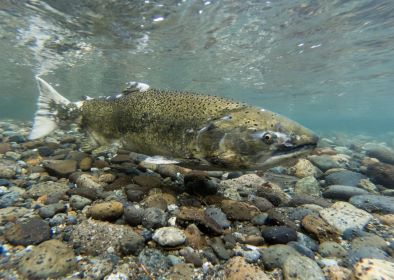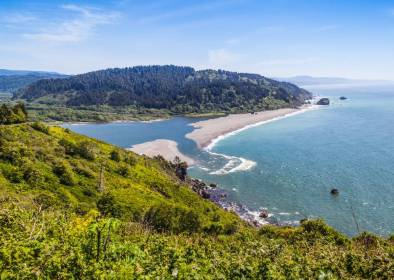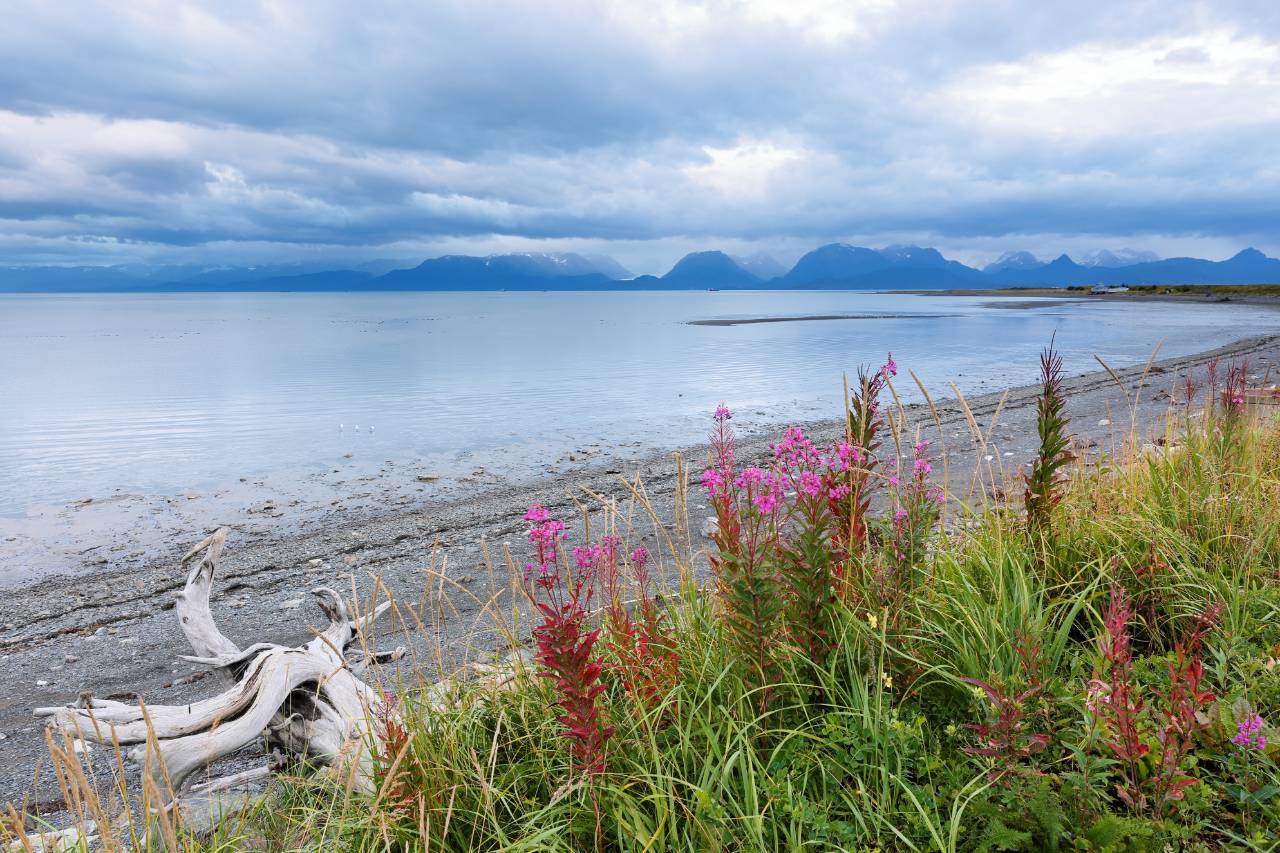Fisheries and traditional knowledge
The Yurok Tribe in northern California faces numerous environmental issues, in large part caused by dams and past logging in the region.
These environmental issues are likely to worsen as climate change progresses. At the heart of their efforts, Yurok members are trying to save a dwindling salmon population that is a critical foundation of their culture and food supply. They’ve partnered with scientists to monitor fish health and have lobbied the government to remove four dams that have negatively impacted salmon migration and spawning. Previously banned cultural practices are being revived to also help make Yurok lands more resilient. One example is targeted burning of forest patches, which can lower wildfire severity and encourage the growth of specific types of vegetation.
The Yurok people have lived since time immemorial on land stretching over 40 miles along the Pacific coast of northern California and following the Klamath River inland for more than 45 miles. Their lives are intrinsically intertwined with their environment – the plants, the animals, the mountain streams, and importantly, the fish that spawn year after year, acting as a valuable food source for the people. But the land around the Klamath Basin has changed dramatically over the past century. Between 1910 and 1960, four dams were constructed in the region, blocking key inland routes that salmon relied on to spawn. The dams also alter river pooling and flow, which can cause water temperatures to increase during key migration and spawning times, with potential consequences for the salmon population. In the 1950s, a logging company began clear-cutting large sections of the forest, increasing the erosion and accumulation of sediments that further stifled natural river flows. However, the most devastating turn of events for the Yurok came in 2002, when tribe members witnessed thousands of dead salmon strewn along the shores of the Klamath River. A conservative estimate is that 35,000 adult salmon died in a single day, before they had a chance to spawn.
“That was a very emotional day for all Yurok people. We are salmon people,” says Richard Myers, a tribal member. “I believe we’re still feeling the impact of that today. Our harvest is not as big as it used to be.”
“That was a very emotional day for all Yurok people. We are salmon people. I believe we’re still feeling the impact of that today. Our harvest is not as big as it used to be.”
The fish kill was caused by higher concentrations of the parasites Ceratomyxa shasta and Parvicapsula minibicornis in the Klamath River, species that were able to take hold because of warm water temperatures – a trend that climate change will amplify. Like humans, fish need oxygen to survive, and warmer water contains less dissolved oxygen. Warmer water temperatures also affect fish metabolism rates. Both juvenile and adult salmon (called ney-puy by the Yurok) are unable to survive when exposed to water above 77°F (25°C) for more than a week.
The list of ways that climate change could impact the region extends far beyond rising water temperatures, however. Increased drought intensities could reduce the high river flows that wash away parasites, further increasing the risk of infection for fish. In recent years, winter precipitation has increasingly come in the form of rain, rather than snow. Less snow accumulation means the spring melt occurs earlier, and results in lower, warmer water flow in the late spring and summer. Fire seasons are expected to become longer, with increased frequency and severity, and these will also lead to increased floods and erosion because the burned-over land will soak up less water. Warming ocean temperatures cause algal blooms to occur off the coast, which create low-oxygen conditions in the water and produce toxins that enter the food web, sickening humans and animals alike.
As Yurok people increasingly noticed and felt the impacts of these changes, they sought official federal government recognition as a tribe, establishing this status in 1993. This recognition allowed the Yurok Tribe to negotiate with the U.S. government as a sovereign nation and address the environmental issues they were facing – and as a group, they have accomplished a lot.
In 1998, the tribe created the Yurok Tribe Environmental Program (YTEP), which serves to help secure grant money for assessments and facilitate local initiatives. For instance, in 2014 YTEP contributed to an in-depth environmental assessment of Yurok territory, funded by a grant from the U.S. Environmental Protection Agency.
“We only work on concerns that the community members have brought to us,” says the division manager of YTEP, Suzanne Fluharty. “As grants come along, we apply the money where it fits in within our tribal concerns.” All projects include Yurok knowledge, which serves as a valuable baseline for a healthy ecosystem. In general, most project goals focus on restoring the land to its natural state and enhancing forest resilience. After experiencing first-hand the degradation of their land and ecosystems – from the long history of logging to the fish kill of 2002 – the Yurok are determined to protect wildlife, the forest and their way of life.
In partnership with the non-profit organization Western Rivers Conservancy, the tribe has bought back approximately 37,000 acres of its ancestral territory, much of it from a logging company. To pay for the land, the tribe took on a low-interest loan from David and Lucile Packard Foundation and enrolled in California’s Carbon Cap and Trade program to help pay it off. (See more on this program in the New Yorker article about the Yurok Tribe)
“It was a big deal, because tribes were not allowed [to participate in the cap and trade program] in the beginning. They had to petition and take it to court to become part of the carbon trade program,” says Fluharty.
As part of the cap-and-trade program, tribe members monitor the growth of trees, record the trees that are blown down, and calculate the percent of carbon being stored within the plant matter and thus kept out of the atmosphere. Since fully launching the program in 2014, the tribe has sold millions of dollars worth of carbon credits to companies. The proceeds from these carbon trades will be used to reacquire more ancestral land.
With the reacquired land, the Yurok are taking a sustainable forestry management approach that protects salmon, improves water quality and restores old-growth forest. They are replanting trees that will help shade and cool the water. To address erosion caused by extensive historic logging, the Yurok Watershed Restoration Department focuses on logging road rehabilitation, slope stabilization and the removal of stream crossings. Taking measures now to help to the forest be less susceptible to erosion is critical for long-term resilience. This is because climate change may bring longer droughts followed by increasingly intense storms, a combination that will exacerbate erosion.


Climate change also has the potential to increase the risk of wildfires in the region. While the Yurok reservation has been spared from large wildfires in recent decades, wildfires from surrounding areas have shrouded the reservation in smoke for weeks at a time during the summer months. While communities with electricity can use HEPA filters in their homes to reduce smoke exposure, much of the Yurok reservation is without electricity.
To make matters worse, the region has been subjected to about 100 years of fire suppression. The Yurok people once practiced cultural burnings, using fire to clear some of the underbrush. This allows the native plants to take hold, including those which Yurok people use for medicine and basketry. Without regular, controlled burning, the forest has become crowded with plant matter that could fuel the flames of a wildfire. In 2016, the Yurok Cultural Fire Management Council began doing burns on small parcels of land on the Yurok Indian Reservation, but the tribe is still lobbying state and federal agencies to fully restore cultural burning rights.
If they succeed, cultural burnings could help restore natural habitats of the area that existed before logging took place, such as prairies. Restoring prairies in the area would reduce runoff and help rebuild groundwater stores, which feed rivers and streams and provide cooler water. Reintroducing prairies may also bring back certain species, such as elk. With the fish population in the area threatened, the reintroduction of elk and other animals could provide Yurok people with additional food sources.
The Yurok are by no means giving up on saving the fish populations, however. Soon after the devastating fish kill of 2002, the Yurok developed a fish monitoring program, which is co-led with state and federal scientists. Together, they make up a team of about thirty people who trap fish and take spore prints of the gills to measure levels of fungus. If a certain threshold of dead juveniles or adults are found within a 10-mile stretch of the river, the tribe relays this information to dam officials, to justify the release of greater water flows.
Despite these efforts, local salmon runs have been sporadic and the fish population is generally in decline. In a normal season, Myers estimates that a Yurok member would catch 12 cases of salmon, which is shared with family members and traded for other supplies with nearby tribes. Nowadays, he says fishers might only catch 6 cases of fish, and some years are particularly bleak. In 2014, an estimated 98% of juvenile Chinook salmon perished due to higher concentrations of warm-water parasites in the Klamath River, a phenomenon that was linked to drought. Typically, Yurok are allotted thousands of Chinook for subsistence, but three years after the 2014 juvenile fish kill, there were only a few hundred returning Chinook, and the entire fishery harvest was closed.
For many Yurok, a priority for restoring the land and protecting wildlife is the removal of the four dams in the region. In April 2016, the Yurok Tribe, together with the Karuk Tribe, the states of California and Oregon, PacifiCorp, and the U.S. Departments of the Interior and Commerce signed an agreement to remove the dams. This agreement marks the largest dam removal project in U.S. history and one of its biggest salmon restoration efforts. The dams were initially slated to be removed in 2020, but the date has since been pushed back to 2021.
“It has been an all-consuming priority for the tribe to take the dams down. They want natural, wild water,” says Fluharty. “By those dams, there’s no fish ladders, so they block two thirds of the spawning grounds in the river basin. By holding back the water, it warms, it becomes stagnant, it gets full of toxins and algae, and it comes dumping down on the Yurok.”
Myers feels strongly about the dam removal, although he knows it will still take some time for the area to recover. “We have to see the first impact, which probably is not going to look very nice,” he says. “If we can get past that first shed of gunk that’s accumulated because of the dam, lighten it up, and then see the river for what it is, and the wild that it was – that will be a healing point for our people, I believe.”
In September 2019, the Yurok Tribe was one of the first two Indigenous nations in the United States to receive the United Nations Development Programme’s prestigious Equator Prize, acknowledging the Tribe’s forward-looking climate change mitigation work.
Story by: Michelle Hampson (Sept. 2019).
Banner Image: Klamath River Overlook. | Credit: Jairo Rene Leiva / Shutterstock.com.



